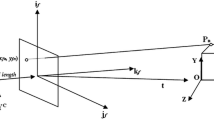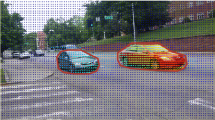Abstract
Considering the field of un-calibrated image sequences and self-calibration, this paper analyzes the use of specific displacements (such as fixed axis rotation, pure translations,...) or specific sets of camera parameters. This allows to induce affine or metric constraints, which can lead to self-calibration and 3D reconstruction.
A uniformed formalism for such models already developed in the literature plus some novel models are developed here. A hierarchy of special situations is described, in order to tailor the most appropriate camera model to either the actual robotic device supporting the camera, or to tailor the fact we only have a reduced set of data available.
This visual motion perception module leads to the estimation of a minimal 3D parameterization of the retinal displacement for a monocular visual system without calibration, and leads to self-calibration and 3D dynamic analysis.
The implementation of these equations is analyzed and experimented.
Similar content being viewed by others
References
Beardsley, P.A., Reid, I.D., Zisserman, A., and Murray, D.W. 1995. Active visual navigation using non-metric structure. In Proceedings of the 5th International Conference on Computer Vision, Boston, MA, IEEE Computer Society Press, pp. 58–64.
Beardsley, P., Zisserman, A., and Murray, D. 1994. Navigation using affine structure from motion. In Proceedings of the 3rd European Conference on Computer Vision, J.-O. Eklundh (Ed.), volume 2 of Lecture Notes in Computer Science, Stockholm, Sweden, Springer-Verlag, pp. 85–96.
Bolles, R.C. and Fischler, M.A. 1981. A RANSAC-based approach to model fitting and its application to finding cylinders in range data. In International Joint Conference on Artificial Intelligence, Vancouver, Canada, pp. 637–643.
Christy, S. and Horaud, R. 1994. Euclidian shape and motion from multiple perspective views by affine iterations. Technical Report 2421, INRIA Rhones-Alpes.
Enciso, R. and Viéville, T. 1995. Experimental self-calibration from focus views lecture. Notes in Computer Science, vol. 976, pp. 307–315.
Enciso, R., Zisserman, A., and Viéville, T. 1996. An affine solution to the euclidean calibration while using a zoom lens. In Workshop ALCATECH, 21–27, Denmark.
Faugeras, O. 1993. Three-Dimensional Computer Vision: A Geometric Viewpoint. MIT Press.
Faugeras, O. 1995. Stratification of 3D vision: Projective, affine, and metric representations. Journal of the Optical Society of America A, 12(3):465–484.
Faugeras, O. and Maybank, S. 1990. Motion from point matches: Multiplicity of solutions. The International Journal of Computer Vision, 4(3):225–246. Also INRIA Tech. Report 1157.
Harris, C. and Stephens, M. 1988. A combined corner and edge detector. In Proc. 4th Alvey Vision Conf., pp. 189–192.
Hartley, R. 1994a. Projective reconstruction and invariants from multiple images. PAMI, 16(10):1036–1040.
Hartley, R. 1994b. Self-calibration from multiple views with a rotating camera. In Proceedings of the 3rd European Conference on Computer Vision, J.-O. Eklundh (Ed.), volumes 800–801 of Lecture Notes in Computer Science, Stockholm, Sweden, Springer-Verlag, pp. 471–478.
Hartley, R.I. 1995. A linear method for reconstruction from lines and points. In Proceedings of the 5th International Conference on Computer Vision, Boston, MA, IEEE Computer Society Press, pp.882–887.
Heyden, A. and Åström, K. 1997. Euclidean reconstruction from image sequences with varying and unknown focal length and principal point. In Comp. Vision and Pattern Rec., IEEE Computer Society Press, pp. 438–443.
Huber, P. 1981. Robust Statistics. John Wiley & Sons: New York.
Kanatani, K. 1992. Geometric Computation for Machine Vision. Oxford University Press.
Lavest, J., Rives, G., and Dhome, M. 1993. 3-D reconstruction by zooming. IEEE Trans. on Robotics and Automation, 9(2): 196–207.
Lingrand, D. and Viéville, T. 1996. Dynamic foveal 3D sensing using affine models. In 13th ICPR, vol. 1, pp. 810–814.
Luong, Q.-T. 1992. Matrice Fondamentale et Calibration Visuelle sur l'Environnement-Vers une plus grande autonomie des systèmes robotiques. Ph.D. Thesis, Université de Paris-Sud, Centre d'Orsay.
Luong, Q.-T. and Faugeras, O. 1995. The fundamental matrix: Theory, algorithms, and stability analysis. The International Journal of Computer Vision, 17(1):43–76.
Maybank, S. 1990. Properties of essential matrices. International Journal of Imaging Systems and Technology, 2:380–384.
Maybank, S.J. and Faugeras, O.D. 1992. A theory of self-calibration of a moving camera. The International Journal of Computer Vision, 8(2):123–152.
Pollefeys, M., Van Gool, L., and Moons, T. 1995. Euclidean 3D reconstruction from stereo sequences with variable focal lenghts. In Proceedings of the 2nd Asian Conference on Computer Vision, Singapore, vol. 2, p. 6.
Rousseeuw, P. and Leroy, A. 1987. Robust Regression and Outlier Detection. John Wiley & Sons: New York.
Shapiro, L. and Brady, M. 1993. Rejecting outliers and estimating errors in an orthogonal regression framework. Tech. Report OUEL 1974/93, Dept. Engineering Science, University of Oxford.
Shashua, A. 1994. Projective structure from uncalibrated images: structure from motion and recognition. IEEE Transactions on Pattern Analysis and Machine Intelligence, 16(8):778–790.
Shashua, A. and Navab, N. 1994. Relative affine structure: Theory and application to 3D reconstruction from perspective views. In Proceedings of the International Conference on Computer Vision and Pattern Recognition, Seattle, WA, IEEE.
Stein, G.P. 1995. Accurate internal camera calibration using rotation with analysis of sources of error. In Proceedings of the 5th International Conference on Computer Vision, Boston, MA, IEEE Computer Society Press.
Sturm, P. 1997. Critical motion sequences for monocular self-calibration and uncalibrated euclidean reconstruction. In Proceedings of the Conference on Computer Vision and Pattern Recognition, Puerto Rico, USA, pp. 1100–1105.
Torr, P. 1997. An assessment of information criteria for motion model selection. In Comp. Vision and Pattern Rec., IEEE Computer Society Press, pp. 47–52.
Torr, P., Zisserman, A., and Maybank, S. 1995. Robust detection of degenerate configurations for the fundamental matrix. In Proceedings of the 5th International Conference on Computer Vision, Boston, MA, IEEE Computer Society Press, pp. 1037–1042.
Van Gool, L., Moons, T., Proesmans, M., and Van Diest, M. 1994. Affine reconstruction from perspective image pairs obtained by a translating camera. In Proceedings of the International Conference on Pattern Recognition, Jerusalem, Israel, Computer Society Press.
Viéville, T. 1994. Autocalibration of visual sensor parameters on a robotic head. Image and Vision Computing, 12.
Viéville, T., Clergue, E., Enciso, R., and Mathieu, H. 1995. Experimentating with 3D vision on a robotic head. Robotics and Autonomous Systems, 14(1).
Viéville, T., Facao, P., and Clergue, E. 1995. Computation of egomotion using the vertical cue. Machine Vision and Applications, 8(1):41–52.
Viéville, T., Faugeras, O.D., and Luong, Q.-T. 1996. Motion of points and lines in the uncalibrated case. The International Journal of Computer Vision, 17(1):7–42.
Viéville, T. and Lingrand, D. 1996. Using singular displacements for uncalibrated monocular visual systems. In 4th ECCV, vol. 2, pp.207–216.
Viéville, T., Zeller, C., and Robert, L. 1995. Use vieville-zeller-et al:96. None
Willson, R. 1994. Modeling and Calibration of Automated Zoom Lenses. Ph.D. Thesis, Department of Electrical and Computer Engineering, Carnegie Mellon University.
Zeller, C. and Faugeras, O. 1994. Applications of non-metric vision to some visual guided tasks. In Proceedings of the International Conference on Pattern Recognition, Jerusalem, Israel, Computer Society Press, pp. 132–136. A longer version in INRIA Tech. Report RR2308.
Zhang, Z., Deriche, R., Faugeras, O., and Luong, Q.-T. 1995. A robust technique for matching two uncalibrated images through the recovery of the unknown epipolar geometry. Artificial Intelligence Journal, 78:87–119.
Zisserman, A. and Maybank, S. 1994. A case against epipolar geometry. In Applications of Invariance in Computer Vision, J.L. Mundy, A. Zissermann, and D. Forsyth (Eds.), volume 825 of Lecture Notes in Computer Science, Springer-Verlag.
Author information
Authors and Affiliations
Rights and permissions
About this article
Cite this article
Viéville, T., Lingrand, D. Using Specific Displacements to Analyze Motion without Calibration. International Journal of Computer Vision 31, 5–29 (1999). https://doi.org/10.1023/A:1008082308694
Issue Date:
DOI: https://doi.org/10.1023/A:1008082308694




